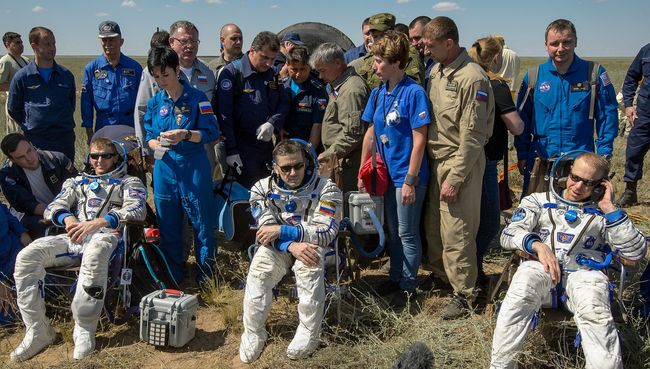Main » Entries archive
 Soyuz TMA-19M spacecraft landed. Soyuz TMA-19M spacecraft landed.
On June 18, 2016 at 09:15 UTC the Russian “Soyuz TMA-19M” landing capsule landed safely in a distance of 150 kilometers from the city of Dzhezkazgan, Kazakhstan.

photo by NASA
The spacecraft delivered to Earth the 3 members of ISS’s Expedition 47 – Russian cosmonaut Yuri Malenchenko, American astronaut Timothy Kopra and British astronaut Timothy Peake. They spent in space 186 days. Three other ISS crew members – Russian cosmonauts Aleksey Ovchinin and Oleg Skripochka as well as American astronaut Jeffrey Williams remained in orbit aboard the International Space Statio
...
Read more »
|
 Russian Soyuz TMA-19M undocked from ISS. Russian Soyuz TMA-19M undocked from ISS.
On June 18, 2016 at 05:52 UTC the Russian “Soyuz TMA-19M” spacecraft undocked from the Russian "Poisk” module of the International Space Station to deliver to Earth the 3 members of Expedition 47 – Russian cosmonaut Yuri Malenchenko, American astronaut Timothy Kopra and British astronaut Timothy Peake. |
 Falcon rocket orbited 2 communications satellites. Falcon rocket orbited 2 communications satellites.
On June 15, 2016 at 14:29 UTC the “Falcon-9” rocket-carrier was launched from Cape Canaveral launch site. The rocket orbited the Eutelsat 117 West B and ABS 2A communications satellites.
Looking through: 1068 |
Date: 05.07.2016
| Rating: 0.0/0
|
 Cygnus CRS-6 spacecraft was undocked from space station. Cygnus CRS-6 spacecraft was undocked from space station.
On June 14, 2016 the US "Cygnus” (CRS OA--6 “Rick Husband”) unmanned supply spacecraft was undocked from the International Space Station. The spacecraft, which had been attached to the space station since March 26, 2016, was released by astronauts aboard the station using the orbiting complex's huge robotic arm at 13:30 UTC. It was the 5th successful flight of "Cygnus” to the ISS. |
 China launched navigation satellite. China launched navigation satellite.
On June 12, 2016 at 15:30 UTC the Chang Zheng-3C (Long March-3C) rocket-carrier was launched from Xichang Cosmodrome, Sichuan province, southwestern China. The rocket orbited the “Beidou G7” navigation satellite. It is the 23rd satellite for the Beidou system.
Looking through: 1208 |
Date: 05.07.2016
| Rating: 0.0/0
|
 US launched national security satellite. US launched national security satellite.
On June 11, 2016 at 17:51 UTC the “Delta IV Heavy” rocket-carrier was launched from Cape Canaveral launch site of US Air Force. The launch was performed by United Launch Alliance supported by the 45th Space Wing of US Air Force. The rocket orbited the NROL-37 classified satellite for the National Reconnaissance Office. The NROL (National Reconnaissance Office Launch) abbreviation is used to identify classified satellites operated by the United States National Reconnaissance Office.
Looking through: 1124 |
Date: 05.07.2016
| Rating: 0.0/0
|
 Russian “Proton” orbited satellite to Intelsat’s fleet. Russian “Proton” orbited satellite to Intelsat’s fleet.
On June 9, 2016 at 07:10 UTC the Russian "Proton-M” rocket-carrier was launched from Baykonur Cosmodrome. The rocket equipped with the "Briz-M” booster orbited Intelsat DLA-2, a U.S.-built television broadcast satellite into orbit for Intelsat and DirecTV.
Looking through: 1092 |
Date: 05.07.2016
| Rating: 0.0/0
|
 Russia launched satellite to measure Earth’s size and shape. Russia launched satellite to measure Earth’s size and shape.
On June 4, 2016 at 14:00 UTC the “Rockot” rocket-carrier was launched from Plesetsk Cosmodrome, Arkhangelsk region, North Russia. The launch was performed by Russian Aerospace Defence Forces. The rocket equipped with the “Briz-KM” upper stage orbited the Russia GEO-IK 2 geodesy satellite. It is the second spacecraft in Russia’s new generation of GEO-IK 2 measurement stations in orbit to collect geodetic information for a range of military and civilian applications.
Looking through: 1130 |
Date: 26.06.2016
| Rating: 0.0/0
|
 Long March orbited Earth-viewing satellites for China, Argentina. Long March orbited Earth-viewing satellites for China, Argentina.
On May 30, 2016 at 03:17 UTC the “Long March – 4B” (“Changzheng-4B”) rocket-carrier was launched from the Taiyuan Satellite Launch Center in north China's Shanxi Province. The rocket orbited the Ziyuan 3” (№2) a civilian Earth imaging craft to be operated by China’s Satellite Surveying and Mapping Application Center, and two microsatellites owned by Satellogic, a Buenos Aires company aiming to field a network of at least six Earth observation birds by the end of this year.
Looking through: 1094 |
Date: 26.06.2016
| Rating: 0.0/0
|
|





